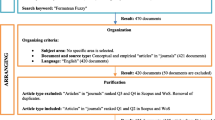Abstract
The concept of intuitionistic fuzzy set (IFS) has extensively used to handle the uncertainty of real-life decision making problems. The aim of this study is to propose an integrated multicriteria group decision making (MCGDM) approach with intuitionistic fuzzy information and apply to select the most suitable renewable energy source with respect to multiple aspects of sustainability criteria. For this purpose, we firstly propose an improved distance measure to quantify the degree of difference between IFSs. Some numerical examples are presented to show the effectiveness of the proposed measure over the existing distance measures under the context of IFS. Further, we develop a weighting approach to find the criteria weights, which combines the objective weighting model using improved distance measure and the subjective weighting model using stepwise weighted assessment ratio analysis (SWARA) with intuitionistic fuzzy information. Based on the proposed criteria weighting model, we develop an integrated weighted aggregated sum product assessment (IF-WASPAS) approach for solving MCGDM problems under intuitionistic fuzzy environment. To prove the applicability and efficacy of the developed approach, we implement it on a case study of renewable energy source selection problem with multiple aspects of sustainability including technical, socio-political, environmental, and economic perspectives. Moreover, the sensitivity and comparative analyses are discussed to examine the feasibility and steadiness of introduced approach in order to assess the RES options. In this paper, we present an improved decision making approach, which makes a significant contribution to the renewable energy sources evaluation process with uncertainty.










Similar content being viewed by others
References
Abdel-Basset M, Gamal A, Chakrabortty RK, Ryan MJ (2021) Evaluation approach for sustainable renewable energy systems under uncertain environment: a case study. Renew Energy 168:1073–1095
Atanassov KT (1986) Intuitionistic fuzzy sets. Fuzzy Sets Syst 20(1):87–96
Bouraima MB, Qiu Y, Stevic Z, Simic V (2023) Assessment of alternative railway systems for sustainable transportation using an integrated IRN SWARA and IRN CoCoSo model. Socioecon Plann Sci. https://doi.org/10.1016/j.seps.2022.101475
Chakraborty S, Saha AK (2022) A framework of LR fuzzy AHP and fuzzy WASPAS for health care waste recycling technology. Appl Soft Comput. https://doi.org/10.1016/j.asoc.2022.109388
Che Y-C, Wang L-H, Chen S-M (2006) Generating weighted fuzzy rules from training data for dealing with the iris data classification problem. Int J Appl Sci Eng 4(1):41–52
Chen S-J, Chen S-M (2001) A new method to measure the similarity between fuzzy numbers. In: 10th IEEE International Conference on Fuzzy Systems. (Cat. No.01CH37297), Melbourne, VIC, Australia, vol 2, pp 1123–1126
Chen S-M, Fang Y-D (2006) A new method to deal with fuzzy classification problems by tuning membership functions for fuzzy classification systems. J Chin Inst Eng 28(1):169–173
Chen S-M, Jian W-S (2017) Fuzzy forecasting based on two-factors second-order fuzzy-trend logical relationship groups, similarity measures and PSO techniques. Inf Sci 391–392:65–79
Chen S-M, Niou S-J (2011) Fuzzy multiple attributes group decision-making based on fuzzy preference relations. Expert Syst Appl 38(4):3865–3872
Chen S-M, Wang N-Y (2010) Fuzzy forecasting based on fuzzy-trend logical relationship groups. IEEE Trans Syst Man Cybern Part B (cybernetics) 40(5):1343–1358
Chen S-M, Ko Y-K, Chang Y-C, Pan J-S (2009) Weighted fuzzy interpolative reasoning based on weighted increment transformation and weighted ratio transformation techniques. IEEE Trans Fuzzy Syst 17(6):1412–1427
Debnath B, Bari ABMM, Haq MM, de Jesus Pacheco DA, Khan MA (2023) An integrated stepwise weight assessment ratio analysis and weighted aggregated sum product assessment framework for sustainable supplier selection in the healthcare supply chains. Supply Chain Anal 1:01–11
Dhankhar C, Kumar K (2023) Multi-attribute decision-making based on the advanced possibility degree measure of intuitionistic fuzzy numbers. Granular Comput 8(467):478
Diemuodeke EO, Addo A, Oko COC, Mulugetta Y, Ojapah MM (2019) Optimal mapping of hybrid renewable energy systems for locations using multi-criteria decision-making algorithm. Renew Energy 134:461–477
Ebadzadeh F, Monavari SM, Jozi SA, Robati M, Rahimi R (2023) An integrated of fuzzy-WASPAS and E-FMEA methods for environmental risk assessment: a case study of petrochemical industry, Iran. Environ Sci Pollut Res 30(40315):40326
Ejegwa PA, Ahemen S (2023) Enhanced intuitionistic fuzzy similarity operators with applications in emergency management and pattern recognition. Granular Comput 8:361–372
Gupta P, Mehlawat MK, Ahemad F (2023) Selection of renewable energy sources: a novel VIKOR approach in an intuitionistic fuzzy linguistic environment. Environ Dev Sustain 25:3429–3467
Hezam IM, Cavallaro F, Lakshmi J, Rani P, Goyal S (2023) Biofuel production plant location selection using integrated picture fuzzy weighted aggregated sum product assessment framework. Sustainability 15:01–20
Kaur G, Majumder A, Yadav R (2022) An efficient generalized fuzzy topsis algorithm for the selection of the hybrid energy resources: a comparative study between single and hybrid energy plant installation in Turkey. RAIRO-Oper Res 56:s1877-1899
Kersuliene V, Zavadskas EK, Turskis Z (2010) Selection of rational dispute resolution method by applying new step-wise weight assessment ratio analysis (SWARA). J Bus Econ Manag 11(2):243–258
Kumar R, Kumar S (2023) A novel intuitionistic fuzzy similarity measure with applications in decision-making, pattern recognition, and clustering problems. Granular Computing 8:1027–1050
Liang Y, Ju Y, Martínez L, Dong P, Wang A (2022) A multi-granular linguistic distribution-based group decision making method for renewable energy technology selection. Appl Soft Comput. https://doi.org/10.1016/j.asoc.2021.108379
Mardani A, Devi S, Alrasheedi M, Arya L, Singh MP, Pandey K (2023) Hybrid intuitionistic fuzzy entropy-SWARA-COPRAS method for multi-criteria sustainable biomass crop type selection. Sustainability 15:01–18
Ming C, Yu X, Zhang B, Yang W (2022) A patent infringement early-warning methodology based on intuitionistic fuzzy sets: a case study of Huawei. Adv Eng Inform. https://doi.org/10.1016/j.aei.2022.101811
Mousavi M, Gitinavard H, Mousavi S (2017) A soft computing based-modified ELECTRE model for renewable energy policy selection with unknown information. Renew Sustain Energy Rev 68:774–787
Olak M, Kaya H (2017) Prioritization of renewable energy alternatives by using an integrated fuzzy MCDM model: a real case application for turkey. Renew Sustain Energy Rev 80:840–853
Ozorhon B, Batmaz A, Caglayan S (2018) Generating a framework to facilitate decision making in renewable energy investments. Renew Sustain Energy Rev 95:217–226
Rani P, Mishra AR (2022) Interval-valued fermatean fuzzy sets with multi-criteria weighted aggregated sum product assessment-based decision analysis framework. Neural Comput Appl 34:8051–8067
Rani P, Mishra AR, Pardasani KR, Mardani A, Liao H, Streimikiene D (2019) A novel VIKOR approach based on entropy and divergence measures of Pythagorean fuzzy sets to evaluate renewableenergy technologies in India. J Clean Prod. https://doi.org/10.1016/j.jclepro.2019.117936
Rani P, Mishra AR, Mardani A, Cavallaro F, Alrasheedi M, Alrashidi A (2020) A novel approach to extended fuzzy TOPSIS based on new divergence measures for renewable energy sources selection. J Clean Prod. https://doi.org/10.1016/j.jclepro.2020.120352
Rudnik K, Bocewicz G, Kucińska-Landwójtowicz A, Czabak-Górska ID (2021) Ordered fuzzy WASPAS method for selection of improvement projects. Expert Syst Appl 169:01–18
Salabun W, Urbaniak k (2020) A new coefficient of rankings similarity in decision-making problems. In: Computational Science- ICCS 2020, vol 15, https://doi.org/10.1007/978-3-030-50417-5_47
Saraç MG, Dedebaş T, Hastaoğlu E, Arslan E (2023) Influence of using scarlet runner bean flour on the production and physicochemical, textural, and sensorial properties of vegan cakes: WASPAS-SWARA techniques. Int J Gastron Food Sci. https://doi.org/10.1016/j.ijgfs.2022.100489
Senapati T, Chen G (2022) Picture fuzzy WASPAS technique and its application in multi-criteria decision-making. Soft Comput 26(9):4413–4421
Shen VRL, Chung YF, Chen SM, Guo JY (2013) A novel reduction approach for Petri net systems based on matching theory. Expert Syst Appl 40(11):4562–4576
Singh A, Kumar S (2023) Intuitionistic fuzzy entropy-based knowledge and accuracy measure with its applications in extended VIKOR approach for solving multi-criteria decision-making. Granular Comput. https://doi.org/10.1007/s41066-023-00386-x
Sitorus F, Brito-Parada PR (2022) The selection of renewable energy technologies using a hybrid subjective and objective multiple criteria decision making method. Expert Syst Appl. https://doi.org/10.1016/j.eswa.2022.117839
Stanujkić D, Karabašević D (2018) An extension of the WASPAS method for decision-making problems with intuitionistic fuzzy numbers: a case of website evaluation. Oper Res Eng Sci Theory Appl 1(1):29–39
Szmidt E, Kacprzyk J (1997) Distances between intuitionistic fuzzy sets. Fuzzy Sets Syst 114:505–518
Tahri M, Hakdaoui M, Maanan M (2015) The evaluation of solar farm locations applying geographic information system and multi-criteria decision-making methods: case study in southern Morocco. Renew Sustain Energy Rev 51:1354–1362
Thanh NV (2022) Sustainable energy source selection for industrial complex in Vietnam: a Fuzzy MCDM Approach. IEEE Access 10:50692–50701
Tripathi DK, Nigam SK, Mishra AR, Shah AR (2023a) A novel intuitionistic fuzzy distance measure-SWARA-COPRAS method for multi-criteria food waste treatment technology selection. Oper Res Eng Sci Theory Appl 6(1):65–94
Tripathi DK, Nigam SK, Rani P, Shah AR (2023b) New intuitionistic fuzzy parametric divergence measures and score function-based CoCoSo method for decision-making problems. Decis Making Appl Manage Eng 6(1):535–563
Verma R (2021) On intuitionistic fuzzy order- α divergence and entropy measures with MABAC method for multiple attribute group decision-making. J Intell Fuzzy Syst 40(1):1191–1217
Wu X, Song Y, Wang Y (2021) Distance-based knowledge measure for intuitionistic fuzzy sets with its application in decision making. Entropy 23:01–26
Xiong L, Zhong S, Liu S, Zhang X, Li Y (2020) An approach for resilient-green supplier selection based on WASPAS, BWM, and TOPSIS under intuitionistic fuzzy sets. Math Probl Eng (Article ID 1761893) 01–18
Xu Z (2007a) Some similarity measures of intuitionistic fuzzy sets and their applications to multiple attribute decision making. Fuzzy Optim Decis Making 6:109–121
Xu Z (2007b) Methods for aggregating interval-valued intuitionistic fuzzy information and their application to decision making. Control Decis 22(2):215–219
Xu Z, Chen J (2008) An overview of distance and similarity measures of intuitionistic fuzzy sets. Internat J Uncertain Fuzziness Knowl-Based Syst 16:529–555
Xu G-L, Wan S-P, Xie X-L (2015) A selection method based on MAGDM with interval-valued intuitionistic fuzzy sets. Math Probl Eng (Article ID 791204):01–13
Zadeh LA (1965) Fuzzy sets. Inf Control 8(3):338–353
Zavadskas EK, Turskis Z, Antucheviciene J, Zakarevicius A (2012) Optimization of weighted aggregated sum product assessment. Elektronika Ir Elektrotechnika 122(6):3–6
Zhang L, Xin H, Yong H, Kan Z (2019) Renewable energy project performance evaluation using a hybrid multi-criteria decision-making approach: case study in Fujian, China. J Clean Prod 206:1123–1137
Acknowledgements
The authors extend their appreciation to King Saud University for funding this work through Researchers Supporting Project number (RSP2023R323), King Saud University, Riyadh, Saudi Arabia.
Author information
Authors and Affiliations
Contributions
Conceptualization, AFA and ARM; methodology, ARM, PR and EKZ; software, PR and AFA.; validation, FC, ARM, and PR; formal analysis, EKZ and ARM; investigation, FC; resources, ARM, PR and AFA; data curation, PR and ARM; writing—original draft preparation, ARM and FC; writing—review and editing, PR and AFA; visualization, ARM; supervision, FC and EKZ; project administration, ARM, PR and FC; funding acquisition, AFA. All authors have read and agreed to the published version of the manuscript.
Corresponding author
Ethics declarations
Conflict of interest
The authors declare no competing interests.
Rights and permissions
Springer Nature or its licensor (e.g. a society or other partner) holds exclusive rights to this article under a publishing agreement with the author(s) or other rightsholder(s); author self-archiving of the accepted manuscript version of this article is solely governed by the terms of such publishing agreement and applicable law.
About this article
Cite this article
Alrasheedi, A.F., Mishra, A.R., Rani, P. et al. Multicriteria group decision making approach based on an improved distance measure, the SWARA method and the WASPAS method. Granul. Comput. 8, 1867–1885 (2023). https://doi.org/10.1007/s41066-023-00413-x
Received:
Accepted:
Published:
Issue Date:
DOI: https://doi.org/10.1007/s41066-023-00413-x




